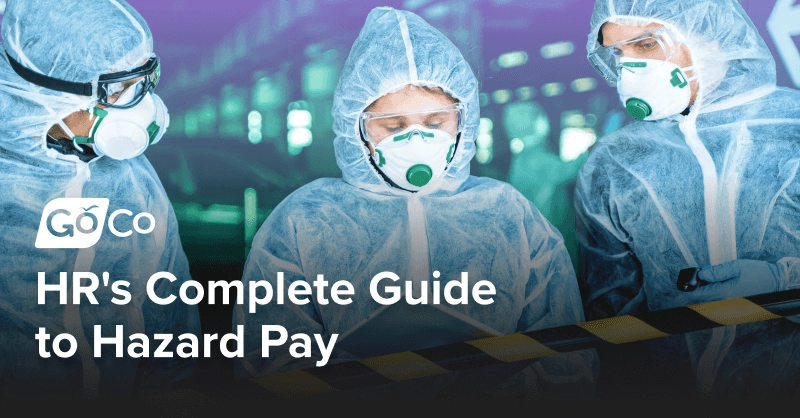HR's Complete Guide to Hazard Pay
A guide to hazard pay, its benefits, and how to develop a program that keeps your employees safe and fairly compensated.
by Anna Coucke - April 12th, 2024
An offshore oil rig, a bustling emergency room, a cramped fishing vessel, a semi-truck traveling in icy weather – these are just a few examples of workplaces where employees face inherent risks every day. But what incentivizes them to brave these dangers every day?
Enter hazard pay—a powerful tool in your HR arsenal for attracting top talent and mitigating risk. In this comprehensive guide, we'll examine hazard pay, its benefits, and how to develop a program that keeps your employees safe and fairly compensated.
What is Hazard Pay?
Hazard pay, also known as hazardous duty pay, is a financial incentive offered to employees who perform duties that expose them to a higher-than-average risk of injury, illness, or death. This additional compensation recognizes the potential dangers associated with the job and recognizes employees for the increased risk they take on.
Hazard pay is typically offered as a premium rate for hours worked in hazardous conditions on top of normal hourly or salaried pay rates, similar to overtime pay.
What Work Conditions Are Considered Hazardous?
The U.S. Department of Labor defines hazardous work as “Work duty that causes extreme physical discomfort and distress which is not adequately alleviated by protective devices is deemed to impose a physical hardship.” and/or “causes extreme physical discomfort and distress which is not adequately alleviated by protective devices.”
In other words, it generally includes situations that pose a higher risk of physical or mental harm. Here are some common examples of hazardous work conditions:
Physical Hazards: Exposure to extreme temperatures, hazardous materials, radiation, dangerous machinery, working at heights, confined spaces, and potential for falls or slips.
Biological Hazards: Working with infectious diseases, bloodborne pathogens, or other biological agents.
Chemical Hazards: Exposure to toxic chemicals, solvents, fumes, or dust.
Environmental Hazards: Working in extreme weather conditions, near wildfires, or in areas with high levels of pollution.
Psychological Hazards: Jobs that expose workers to violence, violent images, or have the potential for psychological trauma.
Is Hazard Pay Required?
Federal law in the United States doesn't require employers to offer hazard pay. However, the Equal Pay Act states that if one employee receives hazard pay within your company, all employees in the same position and conditions are entitled to the same hazard pay.
Certain states and municipalities have their own hazard pay regulations in place, and it's essential for HR professionals to stay updated on local labor laws to ensure compliance. Some may enact temporary hazard pay requirements in response to natural disasters and states of emergency. Check with your HRIS’ compliance software to see if your state has any specific regulations.
Even if it isn’t required by law, offering hazard pay demonstrates your commitment to employee safety and well-being. This can be a significant advantage in attracting and retaining talent, especially for high-risk positions.
What are the Benefits of Offering Hazard Pay?
Implementing a well-structured hazard pay program offers several advantages for your company. By offering competitive hazard pay as a benefit, your company can stand out when attracting and retaining employees by showing them that their safety and well-being are valued and that you are willing to compensate them fairly for the risks they take – leading to higher engagement, productivity, and morale.
Beyond recruitment and retention, offering hazard pay can incentivize safe work practices and discourage shortcuts that might lead to accidents or injuries, ultimately reducing workers' compensation claims, fines, and other associated costs.
How is Hazard Pay Calculated?
Determining hazard pay isn't a one-size-fits-all equation. There are several methods to consider, each with its own advantages.
Percentage of Base Pay: With this method, a percentage (e.g. 10% - 25%) is added to the employee's regular hourly or salaried rate for hours worked under hazardous conditions.
Flat Rate: This approach adds a set dollar amount to each hour or shift that is completed in a hazardous environment.
The most crucial consideration when deciding on the specific hazard pay amount is the severity of the hazard. Jobs with a greater risk of injury or illness naturally warrant a higher level of hazard pay to compensate for the increased danger.
The duration of exposure is another factor to consider, as employees who spend a significant amount of time in hazardous conditions often receive higher overall compensation due to increased dangers. Typically, this is accomplished by offering higher compensation for more tenured employees.
No matter what hazard pay amount and structure you choose, it’s vital that it is competitive within your industry so that you can attract and retain qualified employees. Research what similar companies offer for comparable hazardous jobs in your field and make sure that what your company offers is comparable.
How to Create a Hazard Pay Policy
While a successful hazard pay program will look different depending on your industry and company, keep these best practices in mind when creating yours:
Develop Clear and Consistent Guidelines
Clearly define what constitutes hazardous work in your organization and the specific criteria for receiving hazard pay. Be sure to be as specific as possible to help avoid confusion or disputes.
A good hazard pay policy should include the following:
Which employees and jobs qualify for hazard pay
Which conditions are considered hazardous
Relevant hazard pay laws according to local and state laws
Information on hazard pay rates and distribution
Any exceptions to hazard pay
Communicate Effectively
Communicate the hazard pay program details to all relevant employees, including potential hires during the interview process. Ensure clear and consistent communication through company handbooks, training materials, and internal communication channels. If there are updates or changes made to your policy, communicate this to all employees and have them acknowledge that they understand.
Regular Review and Updates
Be sure to regularly review and update your hazard pay program to reflect changes in regulations and compliance, industry standards, and the nature of your employees’ work environments. It’s a good idea to do a general review annually and stay up-to-date with any upcoming requirements or changes that may affect your company.
Seek Legal Counsel
Before implementing a new policy or making changes to an existing one, consult with an employment lawyer to ensure your hazard pay structure complies with federal, state, and local labor laws.
Final Thoughts
While not a requirement in most cases, offering a hazard pay program signifies a company culture that prioritizes employee safety and well-being. By proactively assessing risks and developing a fair compensation structure, HR professionals can position their companies for success by attracting and retaining skilled workers for high-risk roles while also ensuring a safer and more productive work environment for all.
Recommended Posts
3 Key HR Challenges in the Construction Industry
Blog Articles
Search...
Product
GoCo
Resources
Articles
eBooks
Webinars
Customer Stories







